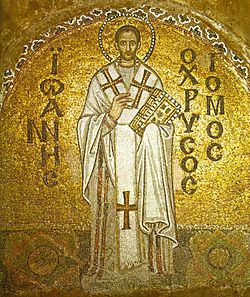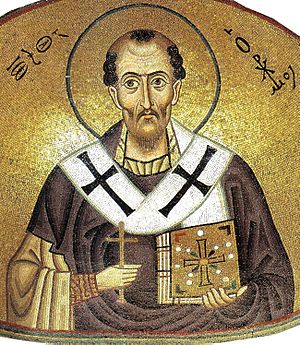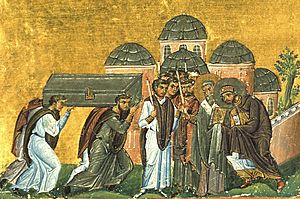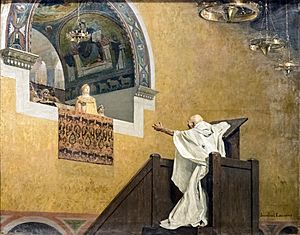John Chrysostom facts for kids
Quick facts for kids SaintJohn Chrysostom |
|
|---|---|

|
|
|
|
| Born | c. 347 Antioch (modern-day Antakya, Hatay, Turkey) |
| Died | 14 September 407 (aged c. 58) Comana in Pontus (region) (modern-day Gümenek, Tokat, Turkey) |
| Venerated in | |
| Canonized | Pre-congregational |
| Feast |
|
| Attributes | Vested as a bishop, holding a Gospel Book or scroll, right hand raised in blessing. He is depicted as emaciated from fasting, with a high forehead, balding with dark hair and a small beard. Symbols: beehive, a white dove, a pan, chalice on a bible, pen and inkhorn |
| Patronage | Constantinople, education, epilepsy, lecturers, public speakers, preachers |
John Chrysostom (/ˈkrɪsəstəm, krɪˈsɒstəm/; Greek: Ἰωάννης ὁ Χρυσόστομος; Ge'ez :ቅዱስ ዮሐንስ አፈወርቅ c. 347 – 14 September 407) was an important Early Church Father who served as archbishop of Constantinople. He is known for his preaching and public speaking, his denunciation of abuse of authority by both ecclesiastical and political leaders, his Divine Liturgy of Saint John Chrysostom, and his ascetic sensibilities. The epithet Χρυσόστομος (Chrysostomos, anglicized as Chrysostom) means "golden-mouthed" in Greek and denotes his celebrated eloquence. Chrysostom was among the most prolific authors in the early Christian Church, although both Origen of Alexandria and Augustine of Hippo exceeded Chrysostom.
He is honoured as a saint in the Oriental Orthodox, Eastern Orthodox, Catholic, Anglican, and Lutheran churches, as well as in some others. The Eastern Orthodox, together with the Byzantine Catholics, hold him in special regard as one of the Three Holy Hierarchs (alongside Basil the Great and Gregory of Nazianzus). The feast days of John Chrysostom in the Eastern Orthodox Church are 14 September, 13 November and 27 January. In the Roman Catholic Church he is recognized as a Doctor of the Church. Because the date of his death is occupied by the feast of the Exaltation of the Holy Cross (14 September), the General Roman Calendar celebrates him since 1970 on the previous day, 13 September; from the 13th century to 1969 it did so on 27 January, the anniversary of the translation of his body to Constantinople. Of other Western churches, including Anglican provinces and Lutheran churches, some commemorate him on 13 September, others on 27 January. John Chrysostom is honored on the calendars of the Church of England and the Episcopal Church on 13 September. The Coptic Church also recognizes him as a saint (with feast days on 16 Thout and 17 Hathor).
Biography
Early life
John was born in Antioch in 347. Different scholars describe his mother Anthusa as a pagan or as a Christian. His father was a high-ranking military officer. John's father died soon after his birth and he was raised by his mother. He was baptised in 368 or 373 and tonsured as a reader (one of the minor orders of the church). It is sometimes said that he was bitten by a snake when he was ten years old, leading to him getting an infection from the bite.
As a result of his mother's influential connections in the city, John began his education under the pagan preacher Libanius. From Libanius, John acquired the skills for a career in rhetoric, as well as a love of the Greek language and literature. Eventually, he became a lawyer.
As he grew older, however, John became more deeply committed to Christianity and went on to study theology under Diodore of Tarsus, founder of the re-constituted School of Antioch. According to the Christian historian Sozomen, Libanius was supposed to have said on his deathbed that John would have been his successor "if the Christians had not taken him from us".
John lived in extreme asceticism and became a hermit in about 375; he spent the next two years continually standing, scarcely sleeping, and committing the Bible to memory. As a consequence of these practices, his stomach and kidneys were permanently damaged and poor health forced him to return to Antioch.
Diaconate and service in Antioch
John was ordained as a deacon in 381 by the bishop Meletius of Antioch who was not then in communion with Alexandria and Rome. After the death of Meletius, John separated himself from the followers of Meletius, without joining Paulinus, the rival of Meletius for the bishopric of Antioch. But after the death of Paulinus he was ordained a presbyter (priest) in 386 by Flavian, the successor of Paulinus. He was destined later to bring about reconciliation between Flavian I of Antioch, Alexandria, and Rome, thus bringing those three sees into communion for the first time in nearly seventy years.
In Antioch, over the course of twelve years (386–397), John gained popularity because of the eloquence of his public speaking at the Golden Church, Antioch's cathedral, especially his insightful expositions of Bible passages and moral teaching. The most valuable of his works from this period are his homilies on various books of the Bible. He emphasised charitable giving and was concerned with the spiritual and temporal needs of the poor.
His straightforward understanding of the Scriptures – in contrast to the Alexandrian tendency towards allegorical interpretation – meant that the themes of his talks were practical, explaining the Bible's application to everyday life. Such straightforward preaching helped Chrysostom to garner popular support.
One incident that happened during his service in Antioch illustrates the influence of his homilies. When Chrysostom arrived in Antioch, Flavian, the bishop of the city, had to intervene with emperor Theodosius I on behalf of citizens who had gone on a rampage mutilating statues of the emperor and his family. During the weeks of Lent in 387, John preached more than twenty homilies in which he entreated the people to see the error of their ways. These made a lasting impression on the general population of the city: many pagans converted to Christianity as a result of the homilies. The city was ultimately spared from severe consequences.
Archbishop of Constantinople
In the autumn of 397, John was appointed archbishop of Constantinople, after having been nominated without his knowledge by the eunuch Eutropius. He had to leave Antioch in secret due to fears that the departure of such a popular figure would cause civil unrest.
During his time as archbishop he adamantly refused to host lavish social gatherings, which made him popular with the common people, but unpopular with wealthy citizens and the clergy. His reforms of the clergy were also unpopular. He told visiting regional preachers to return to the churches they were meant to be serving – without any pay-out. Also he founded a number of hospitals in Constantinople.
His time in Constantinople was more tumultuous than his time in Antioch. Theophilus, the patriarch of Alexandria, wanted to bring Constantinople under his sway and opposed John's appointment to Constantinople. Theophilus had disciplined four Egyptian monks (known as "the Tall Brothers") over their support of Origen's teachings. They fled to John and were welcomed by him. Theophilus therefore accused John of being too partial to the teaching of Origen. He made another enemy in Aelia Eudoxia, wife of emperor Arcadius, who assumed that John's denunciations of extravagance in feminine dress were aimed at herself. Eudoxia, Theophilus and other of his enemies held a synod in 403 (the Synod of the Oak) to charge John, in which his connection to Origen was used against him. It resulted in his deposition and banishment. He was called back by Arcadius almost immediately, as the people became "tumultuous" over his departure, even threatening to burn the imperial palace. There was an earthquake the night of his arrest, which Eudoxia took for a sign of God's anger, prompting her to ask Arcadius for John's reinstatement.
Peace was short-lived. A silver statue of Eudoxia was erected in the Augustaion, near his cathedral, the Constantinian Hagia Sophia. John denounced the dedication ceremonies as pagan and spoke against the empress in harsh terms: "Again Herodias raves; again she is troubled; she dances again; and again desires to receive John's head in a charger", an allusion to the events surrounding the death of John the Baptist. Once again he was banished, this time to the Caucasus in Abkhazia. His banishment sparked riots among his supporters in the capital, and in the fighting the cathedral built by Constantius II was burnt down, necessitating the construction of the second cathedral on the site, the Theodosian Hagia Sophia.
Around 405, John began to lend moral and financial support to Christian monks who were enforcing the emperors' anti-pagan laws, by destroying temples and shrines in Phoenicia and nearby regions.
Exile and death
The causes of John's exile are not clear, though Jennifer Barry suggests that they have to do with his connections to Arianism. Other historians, including Wendy Mayer and Geoffrey Dunn, have argued that "the surplus of evidence reveals a struggle between Johannite and anti-Johannite camps in Constantinople soon after John's departure and for a few years after his death". Faced with exile, John Chrysostom wrote an appeal for help to three churchmen: Pope Innocent I; Venerius, the bishop of Mediolanum (Milan); and Chromatius, the bishop of Aquileia.
Pope Innocent I protested John's banishment from Constantinople to the town of Cucusus (Göksun) in Cappadocia, but to no avail. Innocent sent a delegation to intercede on behalf of John in 405. It was led by Gaudentius of Brescia; Gaudentius and his companions, two bishops, encountered many difficulties and never reached their goal of entering Constantinople.
John wrote letters which still held great influence in Constantinople. As a result of this, he was further exiled from Cucusus (where he stayed from 404 to 407) to Pitiunt (Pityus) (in modern Georgia) where his tomb is a shrine for pilgrims. He never reached this destination, as he died at Comana Pontica on 14 September 407 during the journey. He died in the Presbyterium or community of the clergy belonging to the church of Saint Basiliscus of Comana. His last words are said to have been "Δόξα τῷ Θεῷ πάντων ἕνεκεν" ('Glory be to God for all things').
Veneration and canonization
John came to be venerated as a saint soon after his death. Almost immediately after, an anonymous supporter of John (known as pseudo-Martyrius) wrote a funeral oration to reclaim John as a symbol of Christian orthodoxy. But three decades later, some of his adherents in Constantinople remained in schism. Proclus, archbishop of Constantinople (434–446), hoping to bring about the reconciliation of the Johannites, preached a homily praising his predecessor in the Church of Hagia Sophia. He said, "O John, your life was filled with sorrow, but your death was glorious. Your grave is blessed and reward is great, by the grace and mercy of our Lord Jesus Christ O graced one, having conquered the bounds of time and place! Love has conquered space, unforgetting memory has annihilated the limits, and place does not hinder the miracles of the saint."
These homilies helped to mobilize public opinion, and the patriarch received permission from the emperor to return Chrysostom's relics to Constantinople, where they were enshrined in the Church of the Holy Apostles on 28 January 438. The Eastern Orthodox Church commemorates him as a "Great Ecumenical Teacher", with Basil the Great and Gregory the Theologian. These three saints, in addition to having their own individual commemorations throughout the year, are commemorated together on 30 January, a feast known as the Synaxis of the Three Hierarchs.
In the Eastern Orthodox Church there are several feast days dedicated to him:
- 27 January, Translation of the relics of Saint John Chrysostom from Comana to Constantinople
- 30 January, Synaxis of the Three Great Hierarchs
- 14 September, Repose of Saint John Chrysostom
- 13 November, celebration was transferred from 14 September by the 10th century AD as the Exaltation of the Holy Cross became more prominent. According to Brian Croke, 13 November is the date news of John Chrysostom's death reached Constantinople.
In 1908 Pope Pius X named him the patron saint of preachers.
Writings
Some 700 sermons and 246 letters by John Chrysostom survive, plus biblical commentaries, moral discourses, and theological treatises.
Homilies
Paschal Homily

The best known of his many homilies is an extremely brief one, the Paschal Homily (Hieratikon), which is read at the first service of Pascha (Easter), the midnight Orthros (Matins), in the Eastern Orthodox Church.
General
Chrysostom's extant homiletical works are vast, including many hundreds of exegetical homilies on both the New Testament (especially the works of Paul the Apostle) and the Old Testament (particularly on Genesis). Among his extant exegetical works are sixty-seven homilies on Genesis, fifty-nine on the Psalms, ninety on the Gospel of Matthew, eighty-eight on the Gospel of John, and fifty-five on the Acts of the Apostles.
The homilies were written down by stenographers and subsequently circulated, revealing a style that tended to be direct and greatly personal, but formed by the rhetorical conventions of his time and place. In general, his homiletical theology displays much characteristic of the Antiochian school (i.e., somewhat more literal in interpreting biblical events), but he also uses a good deal of the allegorical interpretation more associated with the Alexandrian school.
John's social and religious world was formed by the continuing and pervasive presence of paganism in the life of the city. One of his regular topics was the paganism in the culture of Constantinople, and in his homilies he thunders against popular pagan amusements: the theatre, horseraces, and the revelry surrounding holidays.
One of the recurring features of John's homilies is his emphasis on care for the needy. Along these lines, he wrote often about the need for almsgiving and its importance alongside fasting and prayer, e.g. "Prayer without almsgiving is unfruitful."

Cyril of Alexandria attributed the destruction of the Ephesian Temple of Artemis to John Chrysostom, referring to him as "the destroyer of the demons and overthrower of the temple of Diana". A later Archbishop of Constantinople, Proclus repeated the allegation, saying "In Ephesus, he despoiled the art of Midas". Both claims are considered spurious.
Homilies against Jews and Judaizing Christians
During his first two years as a presbyter in Antioch (386–387), John denounced Jews and Judaizing Christians in a series of eight homilies delivered to Christians in his congregation who were taking part in Jewish festivals and other Jewish observances. It is disputed whether the main targets were specifically Judaizers or Jews in general. His homilies were expressed in the conventional manner, utilizing the uncompromising rhetorical form known as the psogos (Greek: blame, censure).
One of the purposes of these homilies was to prevent Christians from participating in Jewish customs, and thus prevent the perceived erosion of Chrysostom's flock. In his homilies, John criticized those "Judaizing Christians", who were participating in Jewish festivals and taking part in other Jewish observances, such as the shabbat, and made pilgrimage to Jewish holy places. There had been a revival of Jewish faith and tolerance in Antioch in 361, so Chrysostom's followers and the greater Christian community were in contact with Jews frequently, and Chrysostom was concerned that this interaction would draw Christians away from their faith identity.
John claimed that synagogues were full of Christians, especially Christian women, on the shabbats and Jewish festivals, because they loved the solemnity of the Jewish liturgy and enjoyed listening to the shofar on Rosh Hashanah, and applauded famous preachers in accordance with the contemporary custom. Due to Chrysostom's stature in the Christian church, both locally and within the greater church hierarchy, his sermons were fairly successful in spreading anti-Jewish sentiment. This prompted the introduction of anti-Jewish legislation and social regulations, increasing the separation between the two communities.
In Greek the homilies are called Kata Ioudaiōn (Κατὰ Ἰουδαίων), which is translated as Adversus Judaeos in Latin and 'Against the Jews' in English. The original Benedictine editor of the homilies, Bernard de Montfaucon, gives the following footnote to the title: "A discourse against the Jews; but it was delivered against those who were Judaizing and keeping the fasts with them [the Jews]."
According to Patristics scholars, opposition to any particular view during the late 4th century was conventionally expressed in a manner, utilizing the rhetorical form known as the psogos, whose literary conventions were to vilify opponents in an uncompromising manner; thus, it has been argued that to call Chrysostom an "anti-Semite" is to employ anachronistic terminology in a way incongruous with historical context and record. This does not preclude assertions that Chrysostom's theology was a form of anti-Jewish supersessionism.
Anglican priest James Parkes called Chrysostom's writing on Jews "the most horrible and violent denunciations of Judaism to be found in the writings of a Christian theologian". According to historian William I. Brustein, his sermons against Jews gave further momentum to the idea that Jews are collectively responsible for the death of Jesus. Steven T. Katz cites Chrysostom's homilies as "the decisive turn in the history of Christian anti-Judaism, a turn whose ultimate disfiguring consequence was enacted in the political antisemitism of Adolf Hitler."

Treatises
Apart from his homilies, a number of John's other treatises have had a lasting influence. One such work is John's early treatise Against Those Who Oppose the Monastic Life, written while he was a deacon (sometime before 386), which was directed to parents, pagan as well as Christian, whose sons were contemplating a monastic vocation. Chrysostom wrote that, already in his day, it was customary for Antiochenes to send their sons to be educated by monks.
Another important treatise written by John is titled On the Priesthood (written 390/391, it contains in Book 1 an account of his early years and a defence of his flight from ordination by bishop Meletios of Antioch, and then proceeds in later books to expound on his exalted understanding of the priesthood). Two other notable books by John are Instructions to Catechumens and On the Incomprehensibility of the Divine Nature. In addition, he wrote a series of letters to the deaconess Olympias, of which seventeen are extant.
Liturgy
Beyond his preaching, the other lasting legacy of John is his influence on Christian liturgy. Two of his writings are particularly notable. He harmonized the liturgical life of the church by revising the prayers and rubrics of the Divine Liturgy, or celebration of the Holy Eucharist. To this day, Eastern Orthodox and Eastern Catholic Churches of the Byzantine Rite typically celebrate the Divine Liturgy of Saint John Chrysostom as the normal Eucharistic liturgy, although his exact connection with it remains a matter of debate among experts.
Legacy and influence

During a time when city clergy were subject to criticism for their high lifestyle, John was determined to reform his clergy in Constantinople. These efforts were met with resistance and limited success. He was an excellent preacher whose homilies and writings are still studied and quoted. As a theologian, he has been and continues to be very important in Eastern Christianity, and is generally considered among the Three Holy Hierarchs of the Greek Church, but has been less important to Western Christianity. His writings have survived to the present day more so than any of the other Greek Fathers.
Influence on the Catechism of the Catholic Church and clergy
Regardless of his lesser influence compared to, say, Thomas Aquinas, John's influence on church teachings is interwoven throughout the current Catechism of the Catholic Church (revised 1992).
Christian clerics, such as R. S. Storr, refer to him as "one of the most eloquent preachers who ever since apostolic times have brought to men the divine tidings of truth and love", and the 19th-century John Henry Newman described John as a "bright, cheerful, gentle soul; a sensitive heart".
Music and literature
John's liturgical legacy has inspired several musical compositions. Particularly noteworthy are Sergei Rachmaninoff's Liturgy of St. John Chrysostom, Op. 31, composed in 1910, one of his two major unaccompanied choral works; Pyotr Tchaikovsky's Liturgy of St. John Chrysostom, Op. 41; and Ukrainian composer Kyrylo Stetsenko's Liturgy of St. John Chrysostom. Arvo Pärt's Litany sets Chrysostom's twenty-four prayers, one for each hour of the day, for soli, mixed choir and orchestra. And the compositions of Alexander Grechaninovs Liturgy of Johannes Chrysostomos No. 1, Op. 13 (1897), Liturgy of Johannes Chrysostomos No. 2, Op. 29 (1902), Liturgia Domestica (Liturgy Johannes Chrysostomos No. 3), Op. 79 (1917) and Liturgy of Johannes Chrysostomos No. 4, Op. 177 (1943) are noteworthy.
James Joyce's novel Ulysses includes a character named Mulligan who brings 'Chrysostomos' into another character (Stephen Dedalus)'s mind because Mulligan's gold-stopped teeth and his gift of the gab earn him the title which St. John Chrysostom's preaching earned him, 'golden-mouthed': "[Mulligan] peered sideways up and gave a long low whistle of call, then paused awhile in rapt attention, his even white teeth glistening here and there with gold points. Chrysostomos."
Relics

John Chrysostom died in the city of Comana in 407 on his way to his place of exile. There his relics remained until 438 when, thirty years after his death, they were transferred to Constantinople during the reign of the empress Eudoxia's son, the emperor Theodosius II (408–450), under the guidance of John's disciple, Proclus, who by that time had become archbishop of Constantinople (434–447).
Most of John's relics were looted from Constantinople by crusaders in 1204 and taken to Rome, but some of his bones were returned to the Orthodox Church on 27 November 2004 by Pope John Paul II. Since 2004 the relics have been enshrined in the Church of St. George, Istanbul.
The skull, however, having been kept at the monastery at Vatopedi on Mount Athos in northern Greece, was not among the relics that were taken by the crusaders in the 13th century. In 1655, at the request of Tsar Alexei Mikhailovich, the skull was taken to Russia, for which the monastery was compensated in the sum of 2,000 rubles. In 1693, having received a request from the Vatopedi Monastery for the return of Saint John's skull, Tsar Peter the Great ordered that the skull remain in Russia but that the monastery was to be paid 500 rubles every four years. The Russian state archives document these payments up until 1735. The skull was kept at the Moscow Kremlin, in the Cathedral of the Dormition of the Mother of God, until 1920, when it was confiscated by the Soviets and placed in the Museum of Silver Antiquities. In 1988, in connection with the 1,000th anniversary of the Baptism of Russia, the head, along with other important relics, was returned to the Russian Orthodox Church and kept at the Epiphany Cathedral, until being moved to the Cathedral of Christ the Saviour after its restoration.
Today, the monastery at Vatopedi posits a rival claim to possessing the skull of John Chrysostom, and there a skull is venerated by pilgrims to the monastery as that of Saint John. Two sites in Italy also claim to have the saint's skull: the Basilica di Santa Maria del Fiore in Florence and the Dal Pozzo chapel in Pisa. The right hand of Saint John is preserved on Mount Athos, and numerous smaller relics are scattered throughout the world.
Collected works
Widely used editions of Chrysostom's works are available in Greek, Latin, English, and French. The Greek edition is edited by Sir Henry Savile (eight volumes, Eton, 1613); the most complete Greek and Latin edition is edited by Bernard de Montfaucon (thirteen volumes, Paris, 1718–38, republished in 1834–40, and reprinted in Migne's Patrologia Graeca, volumes 47–64). There is an English translation in the first series of the Nicene and Post-Nicene Fathers (London and New York, 1889–90). A selection of his writings has been published more recently in the original with facing French translation in Sources Chrétiennes.
Cecs.acu.edu.au hosts an online bibliography of scholarship on John Chrysostom.
See also
 In Spanish: Juan Crisóstomo para niños
In Spanish: Juan Crisóstomo para niños
- Saint John Chrysostom, patron saint archive



